



Government & Politics Unit 4 – Activities + Essays

Introduction to the Executive Branch | Government & Politics: Civics for the American Experiment
Video
Video
From the powers of the presidency to the complexity of the federal bureaucracy, the executive branch plays a critical role in shaping daily life in the United States. But how has this branch evolved over time—and why does it matter for a constitutional republic?
Explore the purpose and structure of the executive branch, how the president's powers have expanded, and how executive agencies regulate everything from national defense to children's TV programs. Discover the balance between strong, decisive leadership and the need for restraint, accountability, and civic virtue in a representative democracy.
This video ties into Unit 4 of the Bill of Rights Institute's Government and Politics: Civics for the American Experiment curriculum. Examine the evolving nature of the presidency, the function of the bureaucracy, and how the executive branch influences both government and society, while applying constitutional principles and prudence in evaluating executive decision-making.

Presidential Notes
Activity
Activity
Three presidential transition letters left by modern presidents to their predecessors.
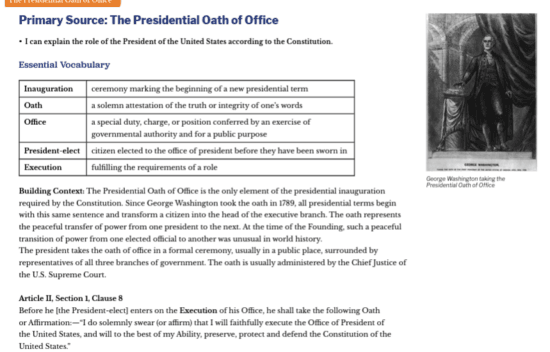
The Presidential Oath of Office
Activity
Activity
The text of Article II, Section 1, Clause 8 that contains the Presidential Oath of Office and corresponding comprehension questions.

What is the Executive Branch?
Essay - 693 Words
Essay
693 Words
Explore the origins, powers, and evolving role of the executive branch under the U.S. Constitution.

Federalist 70
Activity
Activity
The text of Federalist #70 which explore how energy in the executive branch to preserve liberty.

U.S. Constitution, Article II
Activity
Activity
An annotated version of Article II of the U.S. Constitution with key terms defined and comprehension questions.
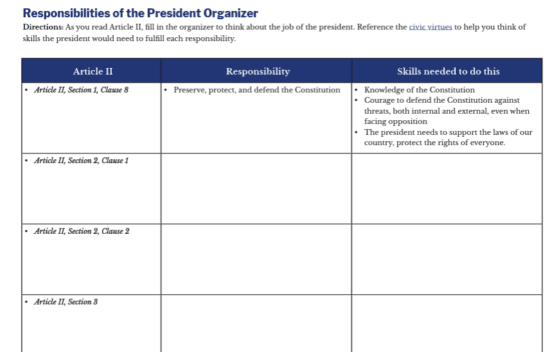
Responsibilities of the President Organizer
Activity
Activity
An activity in which students define the roles of the president and explain the skills and traits required to fulfill these roles.

Executive Branch Job Description Template
Activity
Activity
An activity in which students define the roles of the president and explain the skills and traits required to fulfill these roles.

Presidential Civic Virtue Clue Game
Activity
Activity
An interactive discovery game that explores virtues.
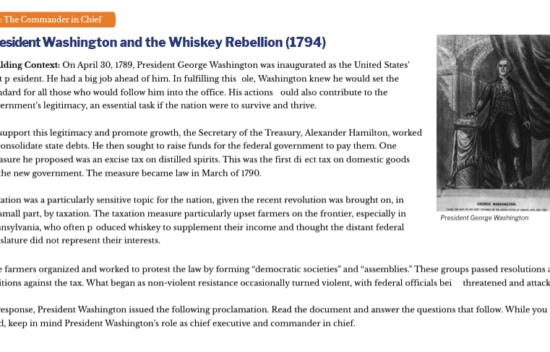
President Washington and the Whiskey Rebellion (1794)
Activity
Activity
The text of Washington's Speech and corresponding comprehension questions.

President Abraham Lincoln at Gettysburg (1863)
Activity
Activity
The Gettysburg Address text and corresponding comprehension questions.

President Woodrow Wilson and the First World War (1917)
Activity
Activity
The text of Woodrow Wilson's Speech and corresponding comprehension questions.

President Harry Truman and Korea (1950)
Activity
Activity
The text of Harry Truman's statement and corresponding comprehension questions.
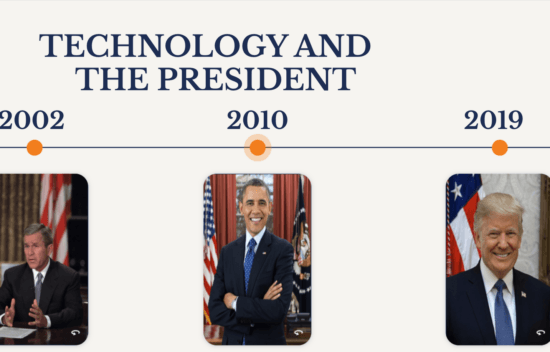
Technology and the President Interactive Timeline
Activity
Activity
An interactive that highlights how technology has increased the reach and influence of the executive branch.
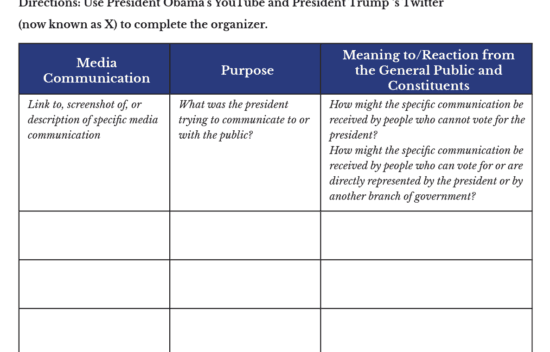
President and Communication Technology Handout
Activity
Activity
How have advancements in communication technology changed how the president communicates with the people?

Candidate-Focused Campaigns & Media Case Study
Essay - 608 Words
Essay
608 Words
Examine how candidates have used media and technology to shape their campaigns and connect with voters throughout history.

Case Study: Presidential War Powers Activity
Activity
Activity
A narrative activity to help students understand how presidential war powers have expanded over time.
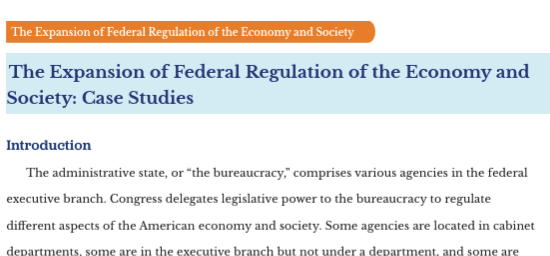
The Expansion of Federal Regulation of the Economy and Society: Case Studies
Essay - 1370 Words
Essay
1370 Words
Explore the expansion of the federal bureaucracy, examining how agencies regulate society and the economy. Students will analyze debates over bureaucratic power, with supporters emphasizing public protection and critics raising concerns about authority concentration and the separation of powers, offering insights into modern governance challenges.

The Bureaucracy | Government & Politics: Civics for the American Experiment
Video
Video
When you think of the executive branch, the president might come to mind—but behind every decision is a vast network of agencies and civil servants. This is the federal bureaucracy.
Explore how the bureaucracy functions, from cabinet officials to over 3 million civil service employees. Learn how these institutions have grown throughout U.S. history, how they affect everything from clean water to transportation safety, and why the balance between accountability and expertise is essential in a constitutional republic. Understand the ongoing debate around bureaucratic power, and why this often-unseen part of government has a very real impact on your everyday life.
This video ties into Unit 4 of the Bill of Rights Institute's Government and Politics: Civics for the American Experiment curriculum. Examine the constitutional foundations, evolution, and daily impact of the federal bureaucracy—and why understanding it is vital for informed civic participation.
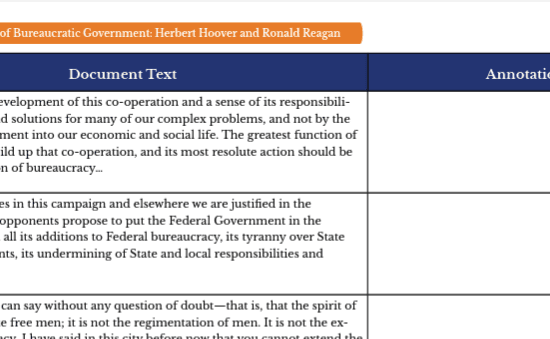
Critics of Bureaucratic Government: Herbert Hoover and Ronald Reagan
Activity
Activity
What is bureaucracy? Primary sources that show how two former presidents critiqued the large federal bureaucracy
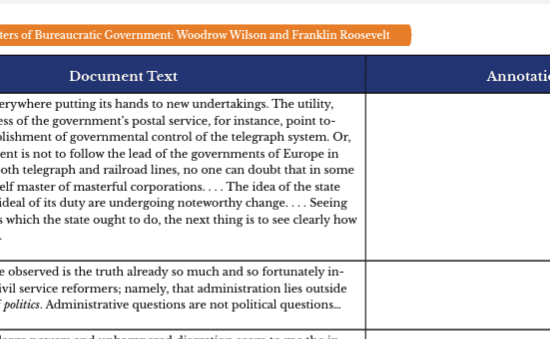
Supporters of Bureaucratic Government: Woodrow Wilson and Franklin Roosevelt
Activity
Activity
What is bureaucracy? Explore primary sources that show how two former presidents supported the idea of the large federal bureaucracy.
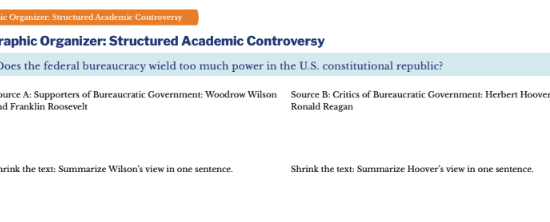
Structured Academic Controversy Graphic Organizer
Activity
Activity
A student activity to accompany the Structured Academic Controversy on the role of the Federal Bureaucracy's Role in the U.S. Constitutional Republic.

Major Departments in the Bureaucracy: Graphic Organizer
Activity
Activity
Help students research, analyze, and evaluate the roles of major bureaucratic departments and their impact on daily life and self-governance.
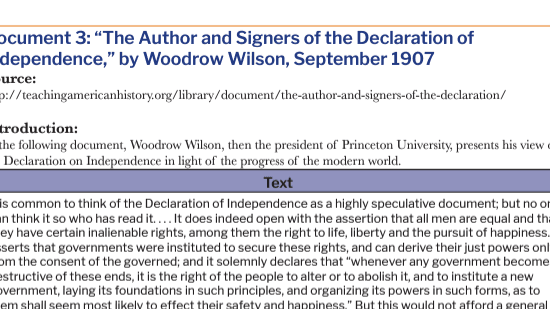
Primary Sources The Progressive Movement DBQ
Activity
Activity
To what extent did the progressives diverge from the Founding in terms of the purposes, scale, and scope of government? Use these the Declaration of Independence, the Constitution, and speeches from Woodrow Wilson, Theodore Roosevelt, Charles Beard, and Calvin Coolidge to help students answer this question.
